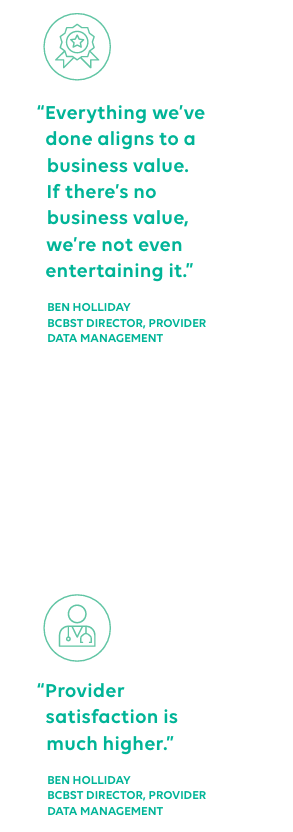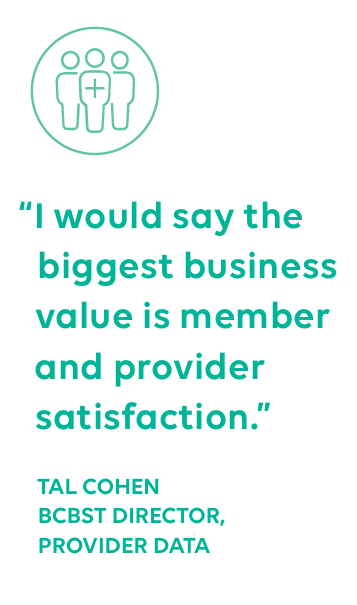CASE STUDY
Centralized Provider Data Management: How BlueCross BlueShield of Tennessee Broke Down Silos and Transformed Operations
The Challenge
- Enrollment, credentialing, contracting and directory functions operated in silos and without an overarching approach to provider data management.
- Provider data operations – individually or collectively – were difficult to measure without performance dashboards.
- Manual processes introduced friction and human error, exacerbating administrative complexity.
The Solution
Executive Buy-In
At the onset, the BCBST provider data operations team worked with their executive leadership to secure funding and create organizational alignment with strategic goals to maximize success. BCBST C-Suite executives acknowledged the importance of reducing enrollment times and agreed to help solve the problem. “Everything we’ve done aligns to a business value,” said Ben Holliday, BCBST director, provider data management. “If there’s no business value, we’re not even entertaining it. While we are a technical team, we’re part of a business unit focused on delivering value to the organization.”
Centralized Ownership
Sufficient funding was secured at the onset of the initiative, dedicated technical teams were assigned to support provider data, and high-caliber analysts were deployed to ensure that all technical work aligned with initial goals. Importantly, the provider data team was established as the organizational owner of the data and empowered to coordinate and update processes among departments involved with the data. BCBST established a process support team and centralized provider enrollment, credentialing, contracting and directory teams under a single vice president.
Real-Time Rostering & Data Integration
A technology infrastructure was established to support and enable process improvements. This involved harmonizing and integrating 25 different systems with three core provider data repositories. BCBST chose not to replace its existing infrastructure with a one-size-fits-all master data management solution, but instead adapt its claims adjudication system to better support provider data operations by integrating with other systems. Partnering with the CAQH implementation and technical teams was key to integrating these once disparate systems into a harmonized data ecosystem. Through coordination and collaboration, the CAQH and BCBST teams were able to fully integrate processing into backend systems to deliver real-time rostering and data retrieval during the enrollment process.
Complete and Accurate Data
Complete and accurate provider data supports the entire data ecosystem and impacts most core business functions at BCBST. There are obvious use cases that relate directly to the provider lifecycle: credentialing, contracting, enrollment, directory updates and network adequacy. Other downstream use cases, including claims adjudication, payment integrity, delivering accurate EOBs, prior authorization and analytics around network performance also rely heavily on accurate provider data.
BCBST strategically selected CAQH as its foundational data set due to its completeness and timeliness. Timeliness is important due to the No Surprises Act requirement for 2-day directory updates, among other federal and state requirements. Using CAQH as the primary data source has allowed BCBST to power a range of use cases while minimizing administrative overhead and complexity. Even when BCBST uses other vendors to support credentialing, payment integrity, or network adequacy, underlying the workflow and insights is up-to-date and complete provider data from CAQH.
Process Automation and Performance Management
BCBST uses API connectivity to ensure that provider profiles are up-to-date and complete before the credentialing and enrollment process starts. BCBST leverages machine-readable data from CAQH to maximize automation for credentialing, directory updates, payment enrollment, and other tasks. This not only accelerates the timeframe to enroll a new provider in BCBST’s network, but also reduces operational costs. By automating these processes and enabling systems-supported hand-offs between different departments, BCBST also collects operational information (presented via 30+ Tableau dashboards) during the overall process. This allows multiple levels of management to measure team and individual performance and creates a positive feedback loop. BCBST can now identify areas that need attention with improvement ideas, empowering the provider network operations team to drive continuous innovation in the enrollment process.
“The reporting is the secret that keeps it moving. That’s the one everyone overlooks,” said Tal Cohen, BCBST director, provider data. “We have 225 provider network operations reports in production and most of those are drillable down to the provider ID level.”

The Results
“In the last seven years, our biggest, broadest network has grown by almost 40% and we haven’t had to hire additional operational staff to support this growth,” said Tal Cohen.
These efforts yielded positive outcomes for BCBST. Provider enrollment time was decreased from 90 days to an average of 22 business days. This resulted in BCBST’s ability to enroll providers faster, and providers now see in-network members faster, access to care has been expanded as appointment delays were eliminated, and practice revenue has accelerated with earlier claims submissions. These improvements resulted in greater provider and member satisfaction and laid the groundwork for a more dynamic provider workforce in Tennessee.
“I would say the biggest business value is member and provider satisfaction. New members may not see it, but they now get to see a new provider more quickly because practices don’t have to push appointments out. Providers have a commitment from us. If you keep your information updated with CAQH, we will not bug you and we don’t. We don’t send them a variety of burdensome forms to fill out like we used to. The CAQH Directory Solution has allowed us to eliminate that and they love it,” said Ben Holliday, Director, Provider Data Management, BlueCross BlueShield of Tennessee.

